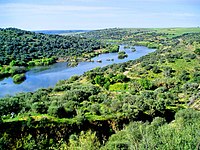
Photo from wikipedia
We predicted the possible direct and indirect phototransformation kinetics of carbamazepine (CBZ), ibuprofen (IBU) and diclofenac (DIC) in river water, based on data of water chemistry obtained for the Guadiana… Click to show full abstract
We predicted the possible direct and indirect phototransformation kinetics of carbamazepine (CBZ), ibuprofen (IBU) and diclofenac (DIC) in river water, based on data of water chemistry obtained for the Guadiana River near Badajoz (Southwestern Spain) during a year-round sampling campaign. The three compounds were chosen, (i) because they occurred at the outlet of the wastewater treatment plant (WWTP) in Badajoz, as well as in river water sampled 1 km downstream of the WWTP, and (ii) because their photochemical fate in surface waters is known well enough to be modelled. The predicted phototransformation kinetics would be negligible in winter and fastest in April-August, with comparable rate constants in April through August despite differences in sunlight irradiance. Favourable water chemistry would in fact offset the lower irradiance, and vice versa. Half-life times of at least three weeks - one month are predicted for CBZ and IBU. Photodegradation may be an important attenuation pathway for biorecalcitrant CBZ, while IBU photochemistry is unlikely to be competitive with other processes including biodegradation. The predicted DIC photochemical half-life times of 7-10 days in April-August would be comparable with the biodegradation kinetics data reported in the literature. Photochemistry might not induce extensive phototransformation of xenobiotics in the Guadiana River under normal flow conditions, but it could become important in the case of low flow produced by water scarcity.
Journal Title: Chemosphere
Year Published: 2018
Link to full text (if available)
Share on Social Media: Sign Up to like & get
recommendations!